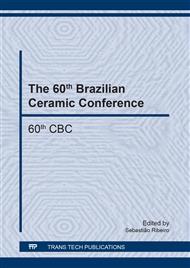p.1
p.7
p.12
p.16
p.21
p.27
p.33
p.39
Removal of Cr(VI) from Aqueous Solutions Using Clay from Calumbi Geological Formation, N. Sra. Socorro, SE State, Brazil
Abstract:
Conventional processes for heavy metal removal are costly. Natural and modified clay with quaternary ammonium salt were used as adsorbent for the removal of Cr (VI) from aqueous solutions. Clays were characterized using Fourier transform infrared spectroscopy FTIR, thermal analysis (TG/DTA) and X-ray diffraction (XRD). Cr (VI) determination was conducted by ultraviolet-visible spectrophotometry, using complexation with 1,5-diphenylcarbazide. Absorbance was measured at the wavelength of 540 nm. The experiments were conducted at 25 ± 1 °C; initial Cr (VI) concentration of 4 to 25 mg L-1; initial pH of 2, agitation of 150 rpm; contact time of 120 minutes and clay mass of 0.1 g. Natural and modified clays exhibited a maximum adsorption capacity of 2.548 mg g-1 and 17.24 mg g-1, respectively, in accordance with the Langmuir isotherm model. X-ray diffraction analysis of clay indicated that the sample consists mainly of kaolinite and montmorillonite.
Info:
Periodical:
Pages:
1-6
Citation:
Online since:
January 2018
Keywords:
Price:
Сopyright:
© 2018 Trans Tech Publications Ltd. All Rights Reserved
Share:
Citation:


